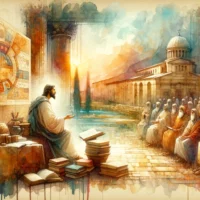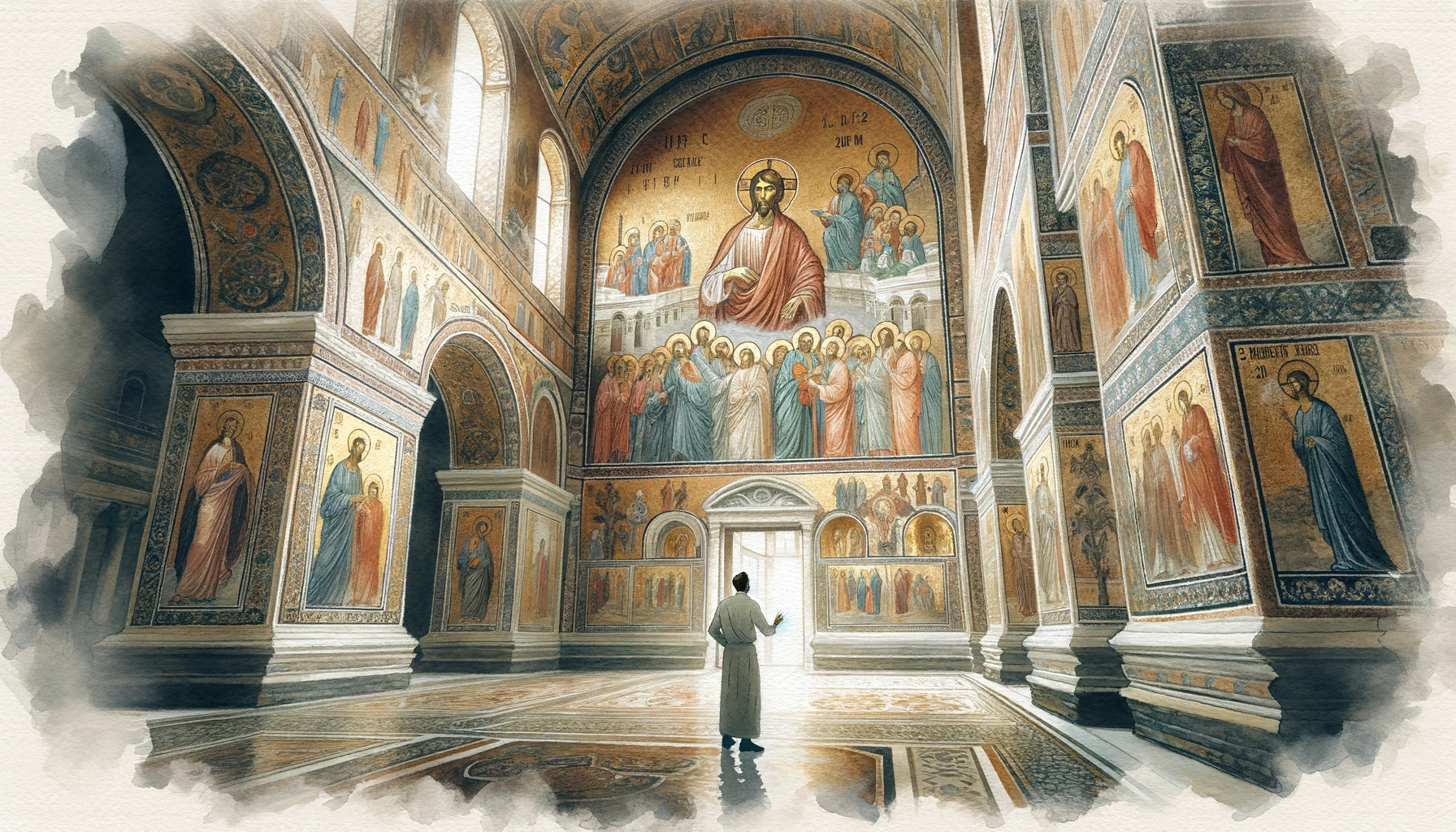The images of Jesus Christ, revered by many across the globe, are an integral part of Christian iconography. Yet, some followers and theologians raise concerns regarding their adherence to Biblical directives, particularly the Ten Commandments. This tension poses a question as relevant today as it was at the dawn of Christianity: Are images of Jesus idolatrous?
Understanding Idolatry in the Biblical Context
Idolatry, as explained in the Holy Scriptures, is the act of worshipping any created thing or image as if it were God Himself (Exodus 20:4-5). This act can take multiple forms, such as worship of physical idols, celestial bodies, or even abstract concepts. The Bible warns us of the consequences of such practices, and God’s expectation of His people is clear – He alone is to be worshipped, not any representations of Him.
This does not mean that the creation of images is itself a sinful act. After all, the Bible describes God instructing His people to construct symbols like the cherubim on the Ark of the Covenant (Exodus 25:18-20). These were not objects of worship but reminders of God’s presence and His divine promises. Here, it’s evident that the issue is not with the images themselves, but with the attitude towards them.
We are called upon to remember that God is invisible, infinite, and beyond human comprehension (1 Timothy 1:17). He cannot be encapsulated within a painting, a statue, or any artistic representation. Such portrayals, if treated with reverence due to God alone, can potentially become idols. But if used as aids for focusing one’s faith and reverence on the God they symbolize, they can have a place within our faith.
This distinction underlines the importance of the intention behind the use of religious imagery. It’s not the image itself that poses a problem, but how it’s viewed and venerated. If worshippers direct their devotion towards the image, mistaking it for God Himself, they risk falling into idolatry. But if they use the image as a reminder of God’s presence and His teachings, it serves to enhance their spiritual connection.
With this understanding, the focus is not on the external object, but on the internal disposition of the believer. Idolatry is, at its core, a heart issue – an issue of misplaced worship. God desires our complete devotion, not to images or representations, but to Him directly (Deuteronomy 6:5).
Idolatry involves the worship of anything other than God, including physical objects or abstract ideas. However, not all images or symbols are inherently idolatrous. The Bible indicates that God approved of certain symbols that reminded His people of His presence and promises. The crux of the matter is the intention and the attitude of the believer. Images or symbols become idolatrous when worshippers venerate them as God Himself, rather than using them as reminders of God’s presence and His teachings. It’s not the image but the act of replacing God with the image that constitutes idolatry. It is a matter of where our hearts direct our devotion.
Interpreting the Second Commandment
Among the Ten Commandments given to Moses on Mount Sinai, the Second Commandment expressly forbids the creation and worship of graven images (Exodus 20:4-5). In its most basic interpretation, this commandment addresses the issue of idolatry, urging followers to avoid replacing the worship of God with the worship of physical representations.
The context of this commandment reflects the historical period when it was delivered. During this time, neighbouring cultures often used idols as a central part of their worship practices, something the Israelites were forbidden to imitate. These cultures believed that the deity resided within the idol, thus treating the object as a god in itself. The Second Commandment served to distinguish the worship practices of the Israelites from these pagan practices.
The Second Commandment instructs us not to create any image with the intention of considering it as God or a god. While it may seem a straightforward command, its interpretation and application can sometimes be nuanced. This commandment doesn’t necessarily prohibit the creation or use of religious art but forbids us from assigning divine status to these images, echoing our discussion of the nature of idolatry.
In Christian theology, God is recognized as transcendent and incomprehensible. We are cautioned against attempting to limit God’s infinite nature to finite, human-made images. Therefore, any image or representation, while it may assist in focusing our minds on spiritual matters, should never be seen as a full or adequate representation of God (Isaiah 40:25).
Some theologians argue that the prohibition of the Second Commandment was directed specifically towards images intended as objects of worship, rather than towards religious art as a whole. This understanding has allowed for the use of religious symbols and imagery in many Christian traditions, provided they are not worshipped as divine entities.
The Second Commandment expressly forbids the creation and worship of idols, in response to the practices of neighbouring cultures during the time of its inception. It serves to maintain the distinctiveness of the worship of God, cautioning against ascribing divine status to physical representations. While some interpret this commandment as prohibiting all religious art, others suggest that it’s specifically targeted towards images intended for worship. Religious images are permissible as long as they are not worshipped as God, reflecting the commandment’s core message to avoid idolatry. This interpretation aligns with the Biblical portrayal of God as infinite and beyond full human comprehension, reinforcing that no image can fully encapsulate His nature.
The Role of Religious Art in Christianity
Art has been a part of the Christian tradition since its earliest days, serving a variety of functions in the life of the Church. From the catacombs’ ancient frescoes to the grandiose mosaics in cathedrals, Christian art has offered a means to express and deepen faith, instruct believers, and commemorate important events and figures within the tradition.
At the center of Christian art, we often find images of Jesus Christ. These images serve as a constant reminder of the central figure of our faith, the Son of God who became incarnate for our salvation (John 1:14). Such images are not considered God themselves but are representations meant to draw our minds and hearts to Jesus.
These images serve as visual aids, helping to communicate complex theological truths in a more tangible, relatable form. They can provide a focal point for prayer and contemplation, guiding the believer’s mind towards the divine. The purpose is not to worship the image but to utilize it as a tool that leads us to a deeper understanding and connection with God.
Historically, there have been disputes over the use of images within Christianity. Iconoclasm, a movement that rejected and destroyed religious images, emerged in the 8th and 9th centuries due to concerns about potential idolatry. Yet, the Second Council of Nicaea in 787 affirmed the appropriateness of veneration (not worship) of icons, asserting their role in teaching and aiding devotion.
While some Christians might prefer to avoid images due to potential confusion or misuse, many others find them helpful in their spiritual journey. This diversity reflects the breadth and depth of Christian tradition, as believers navigate their faith in various ways. The key point is that the use of images should always be guided by the principles outlined in Scripture to ensure they don’t cross the line into idolatry.
Art plays a significant role in Christian tradition, including images of Jesus, as they serve to express and deepen faith, instruct believers, and commemorate Christian history. These images are meant to be aids that guide our minds towards the divine, rather than objects of worship. Despite historical disputes, such as the Iconoclasm movement, the veneration of icons has been affirmed, so long as they do not lead to idolatry. The use of religious images varies among Christians, with some finding them beneficial and others preferring to avoid them to prevent potential misuse. The use of such images should be guided by the teachings of the Bible, ensuring they do not become idols.
The Crossroads of Art and Faith
The question of whether images of Jesus are idolatrous isn’t a simple one to answer. It’s intricately linked with our understanding of idolatry, interpretation of the Second Commandment, and the role of religious art within Christianity. An image of Jesus becomes idolatrous when it replaces God in our hearts, when the image itself becomes the focus of worship. But as a reminder of our faith, as a visual aid to direct our hearts to Jesus, it can serve a purpose within the broader Christian tradition.
As you reflect on this, consider these questions:
- How can we discern the line between veneration and worship in our interaction with religious images?
- How might religious art enhance or hinder our personal spiritual growth?
- How can we ensure that our use of religious images aligns with the teachings of the Bible?
May our faith remain steadfast, our focus on God unwavering, and our hearts always open to the transformative power of His love. Let us keep our eyes fixed on Jesus, the author and perfecter of our faith, whether we choose to use religious art as an aid or not (Hebrews 12:2).














